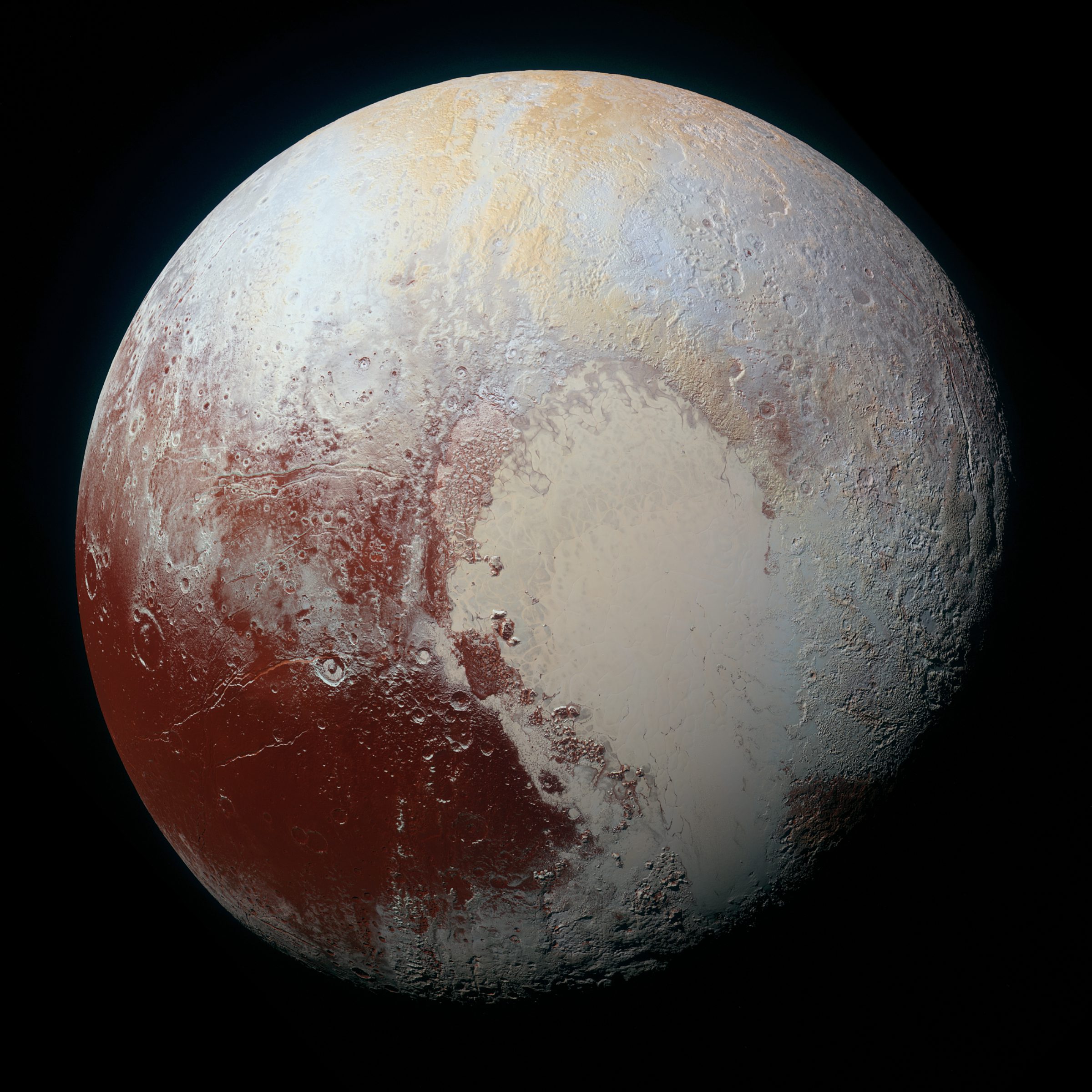Emily Lakdawalla • Sep 24, 2015
Lose yourself in this high-resolution portrait of Pluto
Enlarge this image to its full 8000-pixel-square glory and lose yourself in it. But be careful of your data plan; the full-resolution PNG is 69 MB. (If that gives you pause, here's a JPEG version of the thing at half resolution, a svelte 2 MB.)

This portrait was made from a single MVIC observation, three swaths cut across Pluto with the blue-, red-, and infrared-filter detectors. I wrote last week about how MVIC works to take these images. Because I'd written that article, I realized that, at 8000 pixels square, this portrait was too big to be a single MVIC observation, unless it had been resized. So I asked New Horizons team member Alex Parker about the processing that he did to make it.
Alex confirmed that the image had been upsampled (enlarged) by a factor of 2 as a part of his deconvolution process. I'm oversimplifying here, but deconvolution is a step in image processing where you account for the fact that your detector has an inherent blur. Before you send a scientific camera to space, you perform a lot of tests on it to understand very precisely the geometry of that blur. With an excellent model of its geometry, you can take the blur out, sharpening the images in a way that is very specific to your precise understanding of your scientific camera. Alex said that each image (blue, red, and infrared) was denoised and deconvolved on its own, and then the three images combined into the color view. That was a major step:
This image consumed the better part of this week for me. I removed striping noise and deconvolved the images, massively improving sharpness.
— Alex Parker (@Alex_Parker) September 24, 2015Since the NIR, Red, and Blue images used to make this color composite are taken separately, they have to be precisely aligned in software.
— Alex Parker (@Alex_Parker) September 24, 2015The instrument is a TDI camera, and has funny spatial distortions. I removed all of these by hand to create the final color product.
— Alex Parker (@Alex_Parker) September 24, 2015(Removed with respect to each of the other color channels - a final fully geometrically-corrected image will take more time).
— Alex Parker (@Alex_Parker) September 24, 2015This means going in by hand, determining the size, shape, height, and features of each mountain, and stretching and warping them to match.
— Alex Parker (@Alex_Parker) September 24, 2015My eyes hurt, but I think the result payed off.
— Alex Parker (@Alex_Parker) September 24, 2015Since nobody knows every subtletly of this image better than Alex, I think he's the best person to take you on a tour of it:
Hereafter come some of my favorite bits from the new image.
— Alex Parker (@Alex_Parker) September 24, 2015These vast chasms intersecting this complex crater, with bright materials showing through the walls. pic.twitter.com/fsNQHmzpBA
— Alex Parker (@Alex_Parker) September 24, 2015These spidery fractures on Pluto's horizon, filled with red material. pic.twitter.com/PhlcSbhre6
— Alex Parker (@Alex_Parker) September 24, 2015The subtle blues and golds across Pluto's northern wilds. pic.twitter.com/ApbyDQywWH
— Alex Parker (@Alex_Parker) September 24, 2015The pastel swirls near the shores of Pluto's heart. pic.twitter.com/0RQDtdZNu2
— Alex Parker (@Alex_Parker) September 24, 2015In the future, it should theoretically be possible to employ all three images simultaneously in the deconvolution process, and that might yield even more detail. But the New Horizons team is drowning in pixels at the moment; that's the kind of labor-intensive operation that you do when you're not getting any more data down from your spacecraft and need to wring every last bit of science out of the pixels that you have.
We should get even more pixels tomorrow, when New Horizons releases more raw data. Stay tuned!
Let’s Go Beyond The Horizon
Every success in space exploration is the result of the community of space enthusiasts, like you, who believe it is important. You can help usher in the next great era of space exploration with your gift today.
Donate Today

 Explore Worlds
Explore Worlds Find Life
Find Life Defend Earth
Defend Earth

